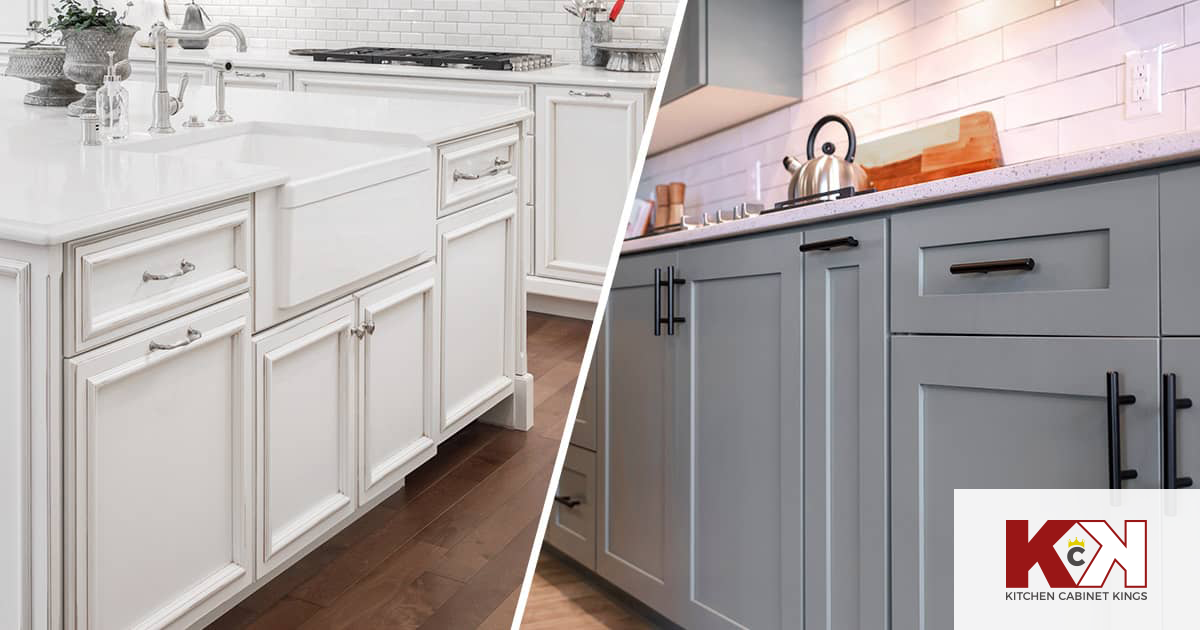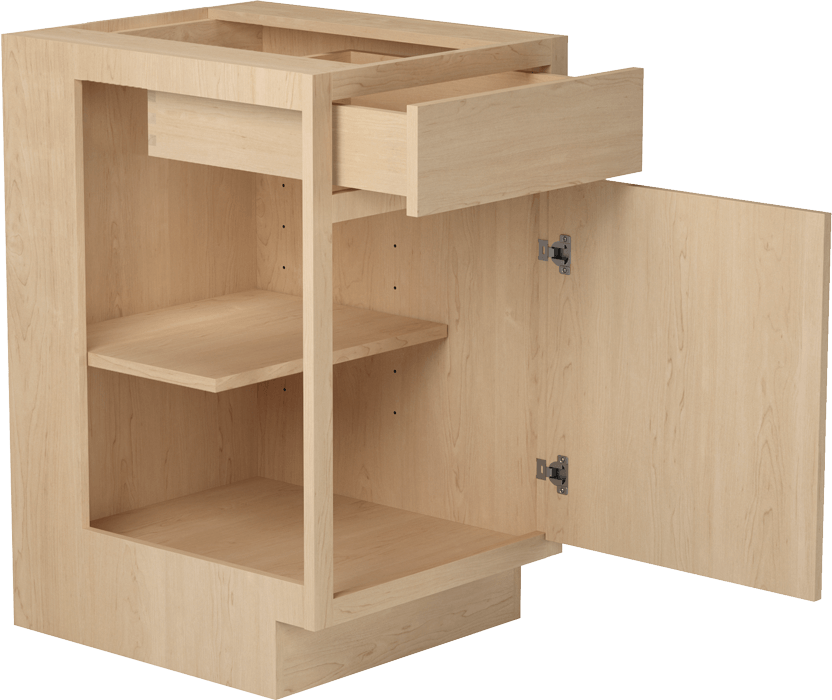Framed kitchen cabinets have a front frame, while frameless cabinets lack this frame, offering more storage space. Framed cabinets are traditional, while frameless provide a modern look.
Kitchen cabinets play a crucial role in both functionality and aesthetics. Framed and frameless cabinets offer distinct styles and benefits. Framed cabinets include a solid wood frame around the cabinet opening, enhancing strength and traditional appeal. Frameless cabinets, often called European-style, maximize storage and offer a sleek, contemporary look.
Homeowners often choose based on personal style, kitchen layout, and storage needs. Understanding the key differences helps in making an informed decision. Both options can fit into various design schemes, but knowing what each offers ensures your kitchen meets your expectations and needs.

Credit: kitchencabinetkings.com
Table of Contents
ToggleFramed Cabinets
Framed cabinets are a classic choice for kitchen designs. They offer a traditional look and robust structure. These cabinets feature a frame that adds strength and style to the overall design. Understanding their unique characteristics can help you decide if framed cabinets are right for your kitchen.
Design Characteristics
Framed cabinets have a distinct design that sets them apart. The cabinet doors attach to the frame, which is visible from the front. This frame offers extra support and durability. The frame can be seen when the doors are closed, giving a traditional look to the kitchen.
Framed cabinets allow for various door options:
- Overlay doors cover most of the frame.
- Inset doors fit inside the frame, offering a flush look.
- Partial overlay doors reveal part of the frame.
The design of framed cabinets makes them a popular choice for many homeowners. Their structure provides a sturdy and reliable option for any kitchen.
Common Materials
Framed cabinets are made from various materials, each offering unique benefits. The most common materials include:
| Material | Characteristics |
|---|---|
| Solid Wood | Durable and classic, offers a warm look. |
| Plywood | Strong and resistant to warping, cost-effective. |
| MDF | Affordable, smooth surface for painting. |
Each material offers different advantages. Solid wood is known for its natural beauty and strength. Plywood offers stability and is less likely to warp over time. MDF provides a smooth surface that is ideal for painted finishes.
Frameless Cabinets
Frameless cabinets are a popular choice for modern kitchens. They offer a sleek, contemporary look without the traditional face frame. This style is also known as European-style cabinets. They provide more accessible storage space and a clean, streamlined appearance.
Design Characteristics
Frameless cabinets have no face frame at the front. This design allows for easy access to the interior. Doors and drawers attach directly to the cabinet box. This results in a smooth, flat exterior. The design offers a minimalist and modern aesthetic. It also maximizes storage space within the cabinet. The absence of a frame allows for wider drawers and doors.
Common Materials
Frameless cabinets often use high-quality materials. Common materials include:
- Medium-Density Fiberboard (MDF): Known for its smooth surface and durability.
- Plywood: Offers excellent strength and stability.
- Particleboard: A cost-effective option, though less durable.
- Laminate: Provides a sleek, modern look with easy maintenance.
These materials ensure that frameless cabinets are both functional and stylish. They offer a variety of finishes and colors to suit any kitchen design.
Aesthetic Differences
Choosing between framed and frameless kitchen cabinets can impact your kitchen’s look. Each type offers unique visual appeal and style versatility. Understanding these differences can help you make an informed decision.
Visual Appeal
Framed kitchen cabinets have a traditional look. They feature a frame around the cabinet box. This frame provides extra strength and support.
On the other hand, frameless kitchen cabinets offer a sleek, modern appearance. They lack a frame, providing a seamless look. This style is popular in contemporary kitchens.
| Framed Cabinets | Frameless Cabinets |
|---|---|
| Traditional look | Modern look |
| Visible frame | Seamless design |
| Extra strength | Less bulky |
Style Versatility
Framed cabinets offer a variety of design options. They can suit many kitchen styles, from rustic to classic. The visible frame allows for detailed craftsmanship.
Frameless cabinets are more versatile for modern and minimalist designs. Their clean lines and smooth surfaces fit well in contemporary settings. They also provide more interior space due to the lack of a frame.
- Framed Cabinets:
- Traditional and classic styles
- Detailed craftsmanship
- Rustic appearance
- Frameless Cabinets:
- Modern and minimalist designs
- Clean lines
- More interior space

Functional Differences
Understanding the functional differences between framed and frameless kitchen cabinets can help you make the best choice for your kitchen. These differences impact storage capacity and accessibility, making your kitchen either more efficient or challenging to use.
Storage Capacity
Framed cabinets feature a frame around the front of the box. This frame slightly reduces the internal storage space. The frame also takes up some of the width, limiting the size of items that can be stored.
Frameless cabinets, also known as European-style cabinets, lack this frame. This allows for more internal space. You can fit larger items in frameless cabinets with ease. The absence of a frame means you get more usable space.
| Framed Cabinets | Frameless Cabinets |
|---|---|
| Reduced internal space | More internal space |
| Frame limits item size | No frame, larger items fit |
Accessibility
Framed cabinets have a center stile between the doors. This stile can make accessing items inside harder. You might have to open both doors to reach items fully.
Frameless cabinets offer better accessibility. They have no center stile, making it easier to reach items. The absence of a frame also means drawers are wider and more accessible.
For those seeking an efficient kitchen, frameless cabinets provide better access to stored items. The design allows for easy movement and quick access.
- Framed Cabinets: Center stile can obstruct access.
- Frameless Cabinets: No center stile, easier access.
Installation Process
Understanding the installation process for framed and frameless kitchen cabinets is essential. Each type has its own set of requirements and complexities. This section will break down the process into two main areas: Complexity Levels and Required Tools.
Complexity Levels
Framed kitchen cabinets are generally easier to install. The frame provides a guide, making alignment straightforward. Frameless cabinets lack this frame, which can make the installation trickier. Precise measurements and alignments are crucial for a seamless look.
Here’s a quick comparison:
| Cabinet Type | Complexity Level |
|---|---|
| Framed | Low to Medium |
| Frameless | Medium to High |
Required Tools
Both types of cabinets require similar tools, but the precision needed for frameless cabinets is higher. Here’s a list of tools you will need:
- Measuring tape
- Level
- Drill
- Screwdriver
- Clamps
For frameless cabinets, adding a laser level can be beneficial. This tool helps ensure exact alignment. Clamps are crucial for holding pieces in place during installation.
For framed cabinets, the built-in frame aids in stability. This makes the need for extra tools like laser levels less critical.

Cost Comparison
When choosing between framed and frameless kitchen cabinets, cost is a crucial factor. Both options have distinct expenses associated with materials and labor. Understanding these costs helps you make an informed decision for your kitchen renovation.
Material Costs
Framed cabinets often use more materials due to their construction. The frame adds extra wood, making them sturdier but more expensive. Common materials for framed cabinets include:
- Solid wood
- Plywood
- Medium-density fiberboard (MDF)
Frameless cabinets require less material, making them a cost-effective choice. They rely on thicker box construction to maintain strength. Typical materials for frameless cabinets are:
- Particleboard
- Plywood
- MDF
Labor Costs
The labor costs for installing framed cabinets are higher. The frame requires precise alignment and additional steps during installation. This increases the time and expertise needed.
On the other hand, frameless cabinets are easier and quicker to install. They have a simpler construction, reducing labor time and costs. Due to the absence of a frame, there is less alignment work required.
| Cabinet Type | Material Cost | Labor Cost |
|---|---|---|
| Framed | Higher | Higher |
| Frameless | Lower | Lower |
Which To Choose?
Choosing between framed and frameless kitchen cabinets can be tough. Both have their pros and cons. Your choice depends on your needs and tastes. Let’s look at some key factors to help you decide.
Personal Preference
Personal taste plays a big role in choosing kitchen cabinets. Some people love the classic look of framed cabinets. They offer a timeless and elegant feel. You can see the frame around the door, giving a traditional look.
Others prefer the sleek and modern look of frameless cabinets. These cabinets have no frame, offering a smooth and clean finish. They often appeal to those who love a minimalist design.
Space Considerations
Space is another vital factor in choosing the right cabinets. Framed cabinets have a frame that takes up some space. This can make the opening smaller.
Frameless cabinets, on the other hand, provide more storage space. Without a frame, you get a bit more room inside. This can be crucial in smaller kitchens.
| Feature | Framed Cabinets | Frameless Cabinets |
|---|---|---|
| Design Style | Traditional | Modern |
| Storage Space | Less | More |
| Stability | More stable | Less stable |
Think about your kitchen space and personal style. Your choice will impact your kitchen’s look and functionality.
Frequently Asked Questions
What Are Framed Kitchen Cabinets?
Framed kitchen cabinets have a front frame that supports the door and adds durability.
What Are Frameless Kitchen Cabinets?
Frameless kitchen cabinets lack a front frame, offering more accessibility and a modern look.
Which Is More Durable, Framed Or Frameless Cabinets?
Framed cabinets are generally more durable due to their supporting front frame.
Do Frameless Cabinets Offer More Space?
Yes, frameless cabinets provide more interior space since they lack the front frame.
Are Framed Cabinets More Traditional?
Framed cabinets usually have a more traditional and classic appearance.
Are Frameless Cabinets More Modern?
Frameless cabinets tend to have a sleek, contemporary look.
Is Installation Easier For Framed Cabinets?
Framed cabinets are often easier to install due to their sturdy front frame.
Do Frameless Cabinets Require Special Hardware?
Yes, frameless cabinets often need specialized hinges and hardware for support.
Which Is More Expensive, Framed Or Frameless?
Frameless cabinets can be more expensive due to precise construction and specialized hardware.
Can I Customize Both Framed And Frameless Cabinets?
Yes, both framed and frameless cabinets offer various customization options to suit your kitchen design.
Conclusion
Choosing between framed and frameless kitchen cabinets depends on your style and functionality needs. Framed cabinets offer traditional charm and durability. Frameless cabinets provide a sleek, modern look with more storage space. Consider your kitchen’s design and your preferences to make the best choice for your home.


